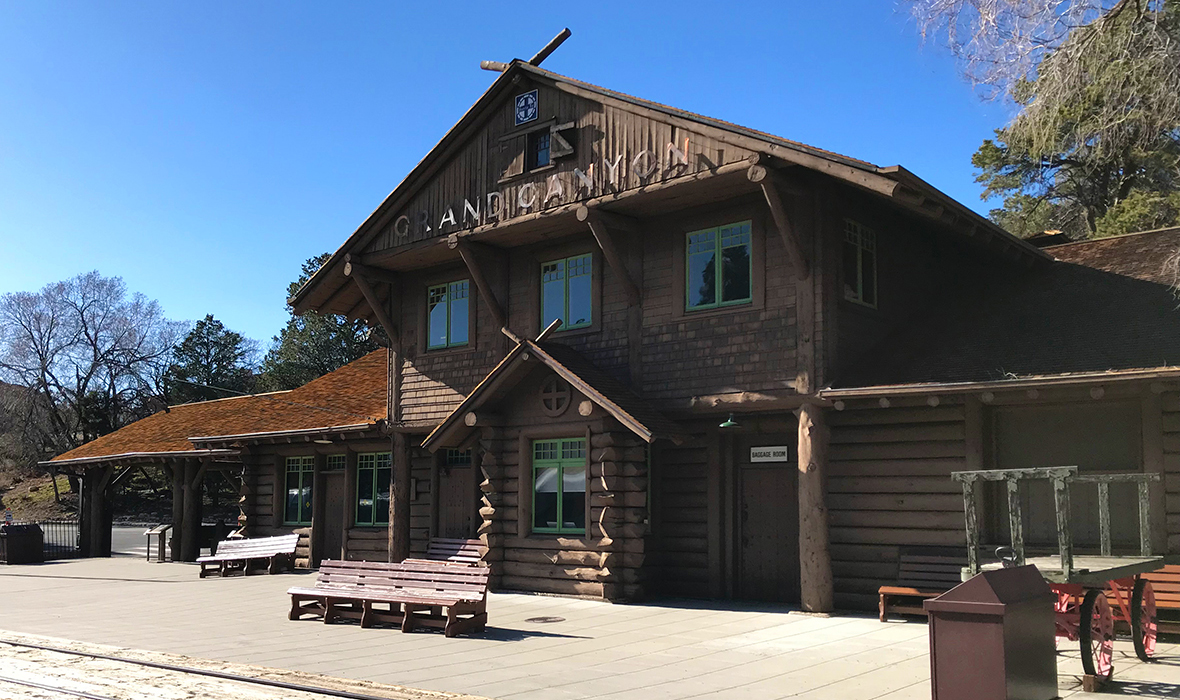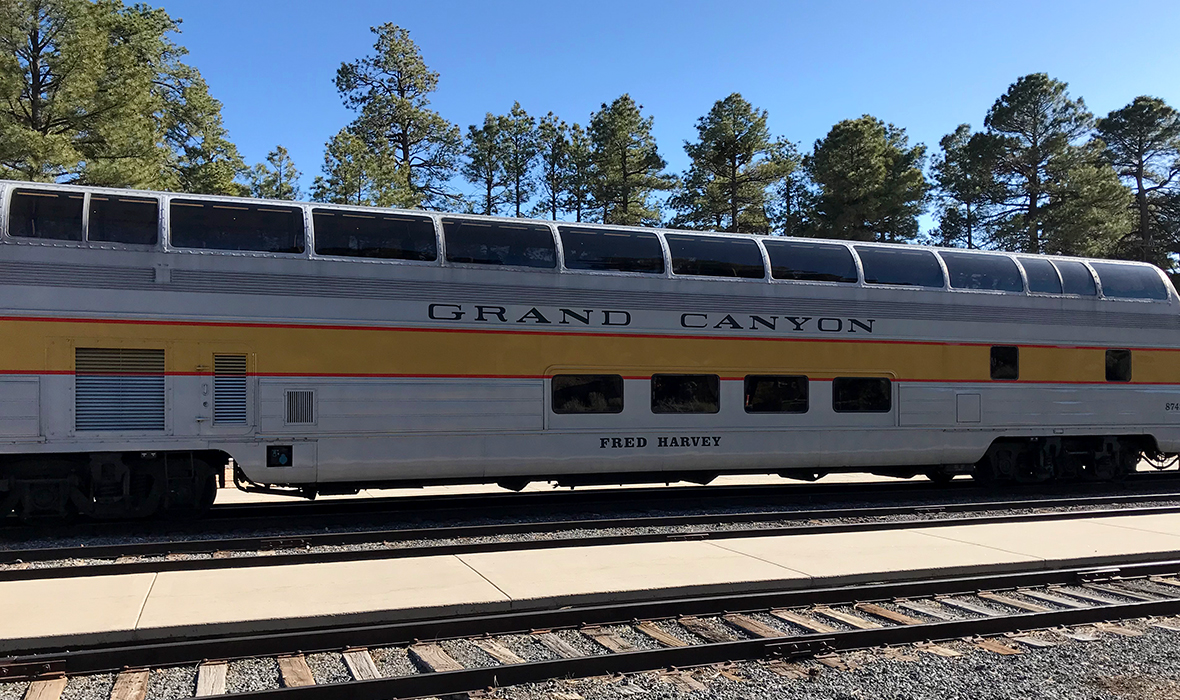
When we decided to head to Grand Canyon National Park for spring break, the first thing we did was look into booking tickets for the Grand Canyon Railway for a historic train ride into the park. But unlike many people who plan their Grand Canyon vacation almost a year in advance, we planned our trip only a few months in advance and not only were tickets sold out for our preferred travel days, we didn’t have time to to the train and do everything else we wanted in the same trip.
Several people we know, including my mom, rave about the Grand Canyon Train experience, including a wild west train robbery, and highly recommend it. But having our own vehicle worked out best in the end for our family for a few reasons:
- We were able to pack all of our own road trip food and snacks and have it with us.
- The free park shuttle buses don’t travel down Desert View Drive, so we were able to explore the Tusayan Ruin and Museum, the Desert View Watchtower, and several scenic viewpoints along the 25 mile road, including Navajo Point, Lipan Point, Moran Point, Grandview Point, and Pipe Creek Vista. (Yaki Point was closed for construction).
- We had more time in our schedule, which allowed us to also squeeze in visits to the Route 66 towns of Kingman and Holbrook, Petrified Forest National Park, Meteor Crater, and Hoover Dam on the same trip.
While we didn’t ride the train, we did have time to visit the Grand Canyon Railway Depot near the El Tovar Hotel in Grand Canyon Village to check out the 100+ year old log depot and the historic trains.
About The Grand Canyon Railway
In 1901, the screech of train brakes signaled a new era in Grand Canyon Village. The railroad provided the most comfortable means of transportation to the canyon for more than a quarter century. The log depot, finished in 1910, welcomed train passengers to a growing village and by 1924, a community development plan was created for the village. Almost a century later, that planned community forms the core of Grand Canyon Village, centering on the last operational log depot in the country. Today Grand Canyon Depot is carefully preserved and still welcomes passengers to the canyon.
With the opening of the paved automotive highway from Williams, Arizona in 1926, ridership on the Grand Canyon Train declined for decades and finally in 1968, the passenger service ceased and the train depot closed. In 1989, Grand Canyon Railway was reopened. The decaying tracks were rebuilt, the historic depots at both ends of the line were restored, and after 21 years, passenger service once again returned to Grand Canyon National Park.
Today, Grand Canyon Railway provides a beautiful, historic 65 mile, 2 hour 15 minute ride from Williams to the Grand Canyon South Rim with the help of authentic western characters and musicians who bring the Old West to life.
Grand Canyon Railway by the Numbers:
- 6: Number of operable diesel engines
- 2: Number of operable steam engines
- 30-40: Miles per hour at which the train travels
- 41: Number of passenger cars (one of the largest fleets in any U.S. excursion railway)
- 65: Track mileage from Williams, Ariz., to the South Rim of the Grand Canyon
- 364: Number of days per year the railway operates (closed on Christmas)
- 1,000,000: Dollar amount it can cost to refurbish a single rail car

Grand Canyon Railway Williams Depot
Grand Canyon Railway departs each day from the historic Williams Depot. Built in 1908 by the Atchison, Topeka and Santa Fe Railroad, the depot was an oasis for travelers heading to and from California along the main line running from Los Angeles to Chicago. It was home to one the Harvey House Hotels, which had 43 rooms, as well as a formal dining room, cafe, bar and a news room.
Listed on the National Register of Historic Places, today the depot is where Grand Canyon Railway passengers pick up their tickets. There is also an expansive gift shop in the depot full of Grand Canyon Railway and Grand Canyon mementos.
The Grand Canyon Depot
The northern terminus of the Grand Canyon Railway line is in Grand Canyon National Park. Built in 1909-1910, Grand Canyon Depot is part of the Grand Canyon National Park Historic District and is a National Historic Landmark. Designed by architect Francis W. Wilson of Santa Barbara, California, the log and wood-frame structure is two stories high.
Originally, the downstairs was designated for station facilities, and the upstairs was for the station agent’s family. But today, the first floor is used for railway passenger services. The building is one of approximately 14 log depots known to have been constructed in the United States, and one of only three remaining.
Just beyond the depot in Grand Canyon Village is the El Tovar Hotel, built in 1905 by the railroad. El Tovar is the premier lodge on the South Rim. The railroad built the depot five years after the hotel and placed it conveniently close for the rail passengers.

Know Before You Go
- Grand Canyon Railway has two train depots, one in Williams and one at the Grand Canyon South Rim. The Grand Canyon Railway Depot in Williams is located at 280 N Grand Canyon Blvd, Williams, Arizona 86046 and the Grand Canyon Railway Station in Grand Canyon National Park is located on Village Loop Drive in Grand Canyon Village, Arizona 86023.
- Tickets range from $67.00/adult and $32.00/child for the Pullman Car to $184.00/adult and $153.00/child for the the Observation Dome with several options in between. There is also a Luxury Dome Class for $219.00/adult, no children.
- The Grand Canyon Railway departs daily at 9:30 am from Williams, Arizona and arrives at Grand Canyon National Park at 11:45 am. It then departs Grand Canyon Depot at 3:30 pm, returning to the Williams Depot at 5:45 pm. During peak travel periods a second train that departs at 10:30 am and returns at 6:45 pm is added.
- Check out special offers and packages to pair lodging and dining with your train ride.
- Grand Canyon Railway is now responsible for keeping approximately 50,000 cars out of the national park.
- The Grand Canyon Railroad Depot was designated a National Historic Landmark in 1987.